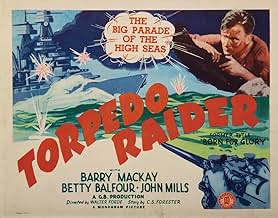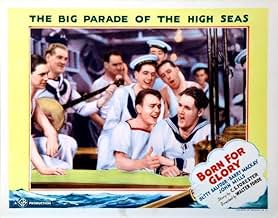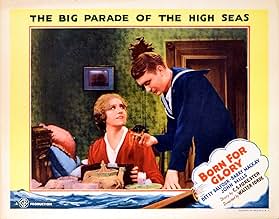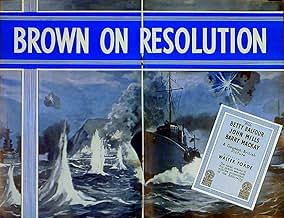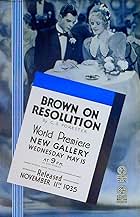Aggiungi una trama nella tua linguaIn 1914, after a German warship picks-up survivors from a sinking British warship it undergoes repairs off a deserted island but it faces sabotage attempts and attacks from one of the escape... Leggi tuttoIn 1914, after a German warship picks-up survivors from a sinking British warship it undergoes repairs off a deserted island but it faces sabotage attempts and attacks from one of the escaped rescued sailors.In 1914, after a German warship picks-up survivors from a sinking British warship it undergoes repairs off a deserted island but it faces sabotage attempts and attacks from one of the escaped rescued sailors.
- Regia
- Sceneggiatura
- Star
- Premi
- 1 vittoria in totale
Barry MacKay
- Lieut. Summerville
- (as Barry Mackay)
Recensioni in evidenza
Pre-WW2 propaganda piece proving that the British people have the sea in their veins and courage in their hearts. Sentiment and nationalism are laid on thickly and there are many special treats for those who enjoy watching model warships floating in a bathtub while pretending to shoot each other.
I doubt there'd have been a dry eye in the house during the 1930s but today you've really got to be in the mood for this kind of thing to rise above cliche. If you could happily watch "Mrs Miniver" or "Goodbye Mr Chips" tonight, then you're already in the right mood.
John Mills in one of his first starring roles gives a genuinely excellent performance as a heroic British naval seaman.
I doubt there'd have been a dry eye in the house during the 1930s but today you've really got to be in the mood for this kind of thing to rise above cliche. If you could happily watch "Mrs Miniver" or "Goodbye Mr Chips" tonight, then you're already in the right mood.
John Mills in one of his first starring roles gives a genuinely excellent performance as a heroic British naval seaman.
When his outmatched ship is sunk by a German one, John Mills is picked up by the Germans. When the Germans put into land to make repairs, Mills escapes with a rifle and determination that they will not make those repairs before a superior British ship can catch up with them.
It's a first for John Mills in a leading role -- although Betty Balfour as his mother is top-billed, her movie career was just about over. It's also a first credit for writer C.S. Forester, whose story this is based on.He wrote the novel on which the earlier PAYMENT DEFERRED (1932) was based, without a screen credit.
Director Walter Forde uses the skills he picked up in the silent cinema to tell the story visually; Mills' climbing atop the rocks and potting the repair workers is accompanied by some German speech, but Mills must use pantomime to convey his thoughts. It must have been an educational experience for his career, which would extend into the 21st Century.
It's a first for John Mills in a leading role -- although Betty Balfour as his mother is top-billed, her movie career was just about over. It's also a first credit for writer C.S. Forester, whose story this is based on.He wrote the novel on which the earlier PAYMENT DEFERRED (1932) was based, without a screen credit.
Director Walter Forde uses the skills he picked up in the silent cinema to tell the story visually; Mills' climbing atop the rocks and potting the repair workers is accompanied by some German speech, but Mills must use pantomime to convey his thoughts. It must have been an educational experience for his career, which would extend into the 21st Century.
When this film was remade by Fox in the fifties audiences were given a choice as to whether Brown lived or died.John Mills early in his film career gives an excellent performance as Brown.Also on his way up is a very young Jimmy Hanley.On her way down is Betty Balfour,star of the silent era,whose attempt at a comeback flopped.There were only two more film appearances after this.
In this, his first starring role in a movie during the course of a remarkable acting career that would span no less than seven decades, John Mills is perfectly cast as a plucky young sailor. This was the first of many heroic rolls that Mills would subsequently fill. In fact, for a while Mills played so many heroes that it was jokingly asserted that Britain could not have won World War II without him.
Originally entitled "Brown on Resolution", this movie is based upon a story by C. S. Forester, the author of the famous Horatio Hornblower novels. However, Like "The African Queen", which was also written by Forester, this naval yarn is set in the early days of World War I.
John Mills plays Albert Brown, a young Royal Navy seaman, the illegitimate son of a Royal Navy Officer who is not actually aware that he has a child at all. Assigned to an antiquated British cruiser in the Pacific, Brown's ship is sunk by a more powerful German warship early in World I. Rescued by the enemy warship, which puts into a lonely Pacific island for repairs, Brown steals a rifle and escapes ashore in an effort to keep the Germans pinned down long enough for his own Navy to arrive on the scene.
This is the sort of old-fashioned "Ripping Yarn" in which the lone hero pits himself against overwhelming odds for reasons of loyalty, duty and honor that would seem incomprehensible to people nowadays, but which struck a deep chord with audiences back then.
Incidentally, this film is also notable to naval history buffs due to the fact that the British Admiralty allowed the producers to use real warships that were in commission at the time. Among those are the battleship HMS Iron Duke, which was the flagship during the 1916 Battle of Jutland, and which was then still in service as a gunnery training ship. Also featured is one of five British light cruisers of the Leander class, all of which subsequently distinguished themselves during World War II, most particularly HMS Ajax and HMS Achilles, which would famously battle the German pocket battleship Graf Spee. Also of note, although for a very different reason, is the WW-I vintage light cruiser cruiser HMS Curacoa, which portrayed the German cruiser in the film. On the night of 2 October 1942 HMS Curacoa was sunk in a tragic collision with the passenger liner Queen Mary. The 80,000 ton liner literally sliced the elderly cruiser in half, like a hot knife through butter. However, the Queen Mary was unable to stop to help the survivors because she was transporting 10,000 badly-needed U.S. Army troops to Britain. For obvious reasons the tragedy had to be hushed up until after the war was over, even the 10,000 troops who were on board the Queen Mary at the time being sworn to secrecy. Although 101 crew members were eventually rescued by other escorting warships, 337 went down with HMS Curacoa,
Originally entitled "Brown on Resolution", this movie is based upon a story by C. S. Forester, the author of the famous Horatio Hornblower novels. However, Like "The African Queen", which was also written by Forester, this naval yarn is set in the early days of World War I.
John Mills plays Albert Brown, a young Royal Navy seaman, the illegitimate son of a Royal Navy Officer who is not actually aware that he has a child at all. Assigned to an antiquated British cruiser in the Pacific, Brown's ship is sunk by a more powerful German warship early in World I. Rescued by the enemy warship, which puts into a lonely Pacific island for repairs, Brown steals a rifle and escapes ashore in an effort to keep the Germans pinned down long enough for his own Navy to arrive on the scene.
This is the sort of old-fashioned "Ripping Yarn" in which the lone hero pits himself against overwhelming odds for reasons of loyalty, duty and honor that would seem incomprehensible to people nowadays, but which struck a deep chord with audiences back then.
Incidentally, this film is also notable to naval history buffs due to the fact that the British Admiralty allowed the producers to use real warships that were in commission at the time. Among those are the battleship HMS Iron Duke, which was the flagship during the 1916 Battle of Jutland, and which was then still in service as a gunnery training ship. Also featured is one of five British light cruisers of the Leander class, all of which subsequently distinguished themselves during World War II, most particularly HMS Ajax and HMS Achilles, which would famously battle the German pocket battleship Graf Spee. Also of note, although for a very different reason, is the WW-I vintage light cruiser cruiser HMS Curacoa, which portrayed the German cruiser in the film. On the night of 2 October 1942 HMS Curacoa was sunk in a tragic collision with the passenger liner Queen Mary. The 80,000 ton liner literally sliced the elderly cruiser in half, like a hot knife through butter. However, the Queen Mary was unable to stop to help the survivors because she was transporting 10,000 badly-needed U.S. Army troops to Britain. For obvious reasons the tragedy had to be hushed up until after the war was over, even the 10,000 troops who were on board the Queen Mary at the time being sworn to secrecy. Although 101 crew members were eventually rescued by other escorting warships, 337 went down with HMS Curacoa,
This is a great film version of CS Forrestor's book of the same title.
I love the book and I love the movie.
Great story of determination in the face of long odds.
Brown one of two able seaman to survive a cruiser sinking after an engagement with a German cruiser is picked up by the damaged German cruiser.
The German cruiser needs repairs and chooses a bay on a rocky inhospitable island.
While the ship is immobile Borown steals a rifle and escapes ashore - he manages to snipe at the Germans repairing the ship for long enough for the rest of the British squadron to find and engage the German cruiser.
I love the book and I love the movie.
Great story of determination in the face of long odds.
Brown one of two able seaman to survive a cruiser sinking after an engagement with a German cruiser is picked up by the damaged German cruiser.
The German cruiser needs repairs and chooses a bay on a rocky inhospitable island.
While the ship is immobile Borown steals a rifle and escapes ashore - he manages to snipe at the Germans repairing the ship for long enough for the rest of the British squadron to find and engage the German cruiser.
Lo sapevi?
- QuizAlthough Betty Balfour is first billed, her role has been so severely shortened in the surviving re-edited version, that very little footage of her still remains.
- BlooperIn the beginning, the ship shown to be in 1893 is a post 1910 made warship.
- Curiosità sui creditiOpening credits prologue: 11th July, 1893.
The opening of the Naval Exhibition at the Crystal Palace.
- ConnessioniVersion of Marinai del re (1953)
- Colonne sonoreDanny Boy
(uncredited)
Traditional tune
Lyrics by Frederick Edward Weatherly
Performed by John Mills, Howard Marion-Crawford and sailors during the ship visit
I più visti
Accedi per valutare e creare un elenco di titoli salvati per ottenere consigli personalizzati
Dettagli
- Data di uscita
- Paese di origine
- Lingue
- Celebre anche come
- Born for Glory
- Luoghi delle riprese
- Nare Head, Cornwall, Inghilterra, Regno Unito(island sequences)
- Azienda produttrice
- Vedi altri crediti dell’azienda su IMDbPro
- Tempo di esecuzione1 ora 20 minuti
- Colore
- Proporzioni
- 1.37 : 1
Contribuisci a questa pagina
Suggerisci una modifica o aggiungi i contenuti mancanti

Divario superiore
By what name was Brown on Resolution (1935) officially released in India in English?
Rispondi
